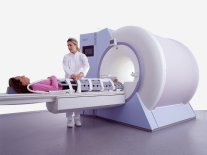 | Info
Sheets |
| | | | | | | | | | | | | | | | | | | | | | | | |
 | Out-
side |
| | | | |
|
| | | | |
Result : Searchterm 'Navigator Technique' found in 1 term [ ] and 3 definitions [ ] and 3 definitions [ ], (+ 1 Boolean[ ], (+ 1 Boolean[ ] results ] results
| 1 - 5 (of 5) Result Pages :  [1] [1] |  | | |  |  |  |
| |
|
The navigator technique measures with an additional quick MR prepulse the position, of e.g. the diaphragm before data collecting. Similar respiratory conditions of the patient can be identified and used to synchronize image data acquisition so that respiration induced image blurring is minimized by either respiratory ordered phase encoding or respiratory gating.
The prepulse sequence images a small area perpendicular to the structure, which is moving. The contrast of the interface between the diaphragm and the lung should be high to permit easy automatic detection.
After data acquisition, the position of the interface is automatically recorded and imaging data are only accepted when the position of the interface falls within a range of prespecified values.
This technique has the advantage of greater accuracy than other respiratory gating (therefore used for coronary angiography) and has no need for additional sensing MRI equipment, as the MR system itself provides it. | |  | | | | • Share the entry 'Navigator Technique':    | | | | | | | | | |
|  | |  |  |  |
| |
|
| |  | |
• View the DATABASE results for 'Coronary Angiography' (7).
| | | | |  Further Reading: Further Reading: | | Basics:
|
|
News & More:
| |
| |
|  | |  |  |  |
| |
|
( FIESTA) The fast imaging employing steady state acquisition sequence provides images of fluid filled structures with very short acquisition times. The FIESTA sequence uses the T2 steady state contrast mechanism to provide high SNR images with strong signal from fluid tissues while suppressing background tissue for contrast and anatomic detail of small structures. In addition, the ultra short TR and TE enable extremely short acquisition times - shorter than FSE - and the images can be post
processed using MIP, volume rendering, or 3D navigator techniques.
See Steady State Free Precession. | |  | | | |
|  | |  |  |  |
| |
|

From Siemens Medical Systems;
while older navigator techniques take up to 40 minutes to create, the high performance of the MAGNETOM Sonata system enables 'complete examinations in less than 15 minutes'. It creates a new standard of diagnostic confidence and moves Cardiac MR from the research setting into routine clinical practice.
Device Information and Specification CLINICAL APPLICATION Whole body Body, head, spine, knee, neck, TMJ, extremity, head, breast, shoulder, others GRE, IR, FIR, STIR, TrueIR/FISP, FSE, FLAIR, MT, SS-FSE, MT-SE, MTC, MSE, EPI, 3D DESS//CISS/PSIF, GMR IMAGING MODES Single, multislice, volume study, multi angle, multi oblique178 images/sec at 256 x 256 at 100% FOV1024 x 1024 full screen display 4050kg, 5500kg in operation POWER REQUIREMENTS 380/400/420/440/480 V Passive, act.; 1st order std./2nd opt. | |  | |
• View the DATABASE results for 'MAGNETOM Sonata™' (2).
| | | | |
|  | |  |  |  |
| |
|
| |  | |
• View the DATABASE results for 'Diffusion Weighted Sequence' (6).
| | | | |  Further Reading: Further Reading: | Basics:
|
|
News & More:
| |
| |
|  | |  |  |
|  | 1 - 5 (of 5) Result Pages :  [1] [1] |
| |
|
| |
 | Look
Ups |
| |